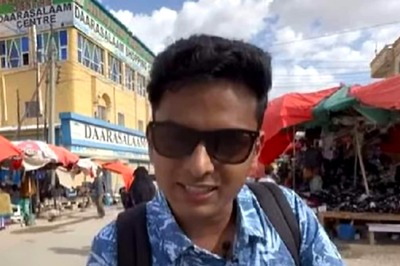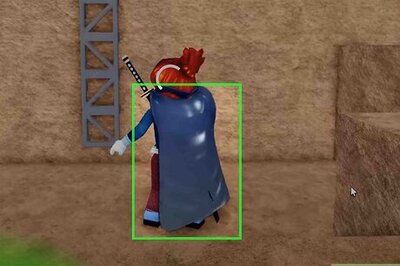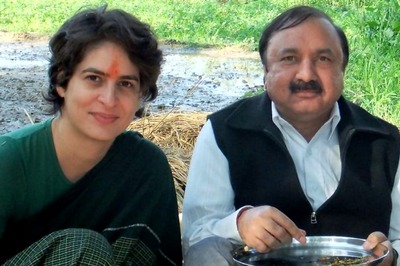
views
Gaming
"Let's Play"s. Gaming content is very popular online, and one of the most popular types of YouTube gaming videos is a "Let's Play." Let's Play videos involve the creator playing through the entirety of a game so viewers can experience a game they can't play on their own for whatever reason. While many Let's Play channels will also talk (reacting or giving commentary to what's going on in the game), there's also a lot of viewers who are looking for game playthroughs without any talking. If you have a particular genre you like to play you can focus on just that genre to create a niche for yourself. This is a good way to identify an audience. If you like to play a lot of different games, you can market your channel as a "variety gaming" channel.
Walkthroughs and strategy. If you're really good at gaming and also like to teach, you might find a good niche for yourself making gaming walkthrough or strategy videos. As long as games continue to release challenging and interesting gameplay (such as battles, puzzles, and more), there will be a need for walkthroughs and strategy videos. While you can and should create content for any game that you are passionate and knowledgeable about, making videos for trending or new games is a good way to draw in an audience.
VTubing. Being a VTuber is very popular right now, because it allows you to stream and make content without having to show your face, plus you get the added benefit of showing off your personality by creating a custom avatar to represent yourself in your videos. While VTubers are mostly popular on Twitch, you can use a VTuber model to create videos. You can also be a Twitch VTuber and upload your Twitch VODs to YouTube. While many VTubers are also gaming content creators, you can technically use a VTuber model for any type of video where you don't want to show your face but you still want an on-camera presence. If you don't want a VTuber model (or you don't want to buy one, as they can be very expensive) you can become what's called a PNGTuber. PNGTubers are similar to VTubers, but instead of a 3D model that represents you on screen, there's a series of images (or PNGs, an image filetype) with varying expressions that change based on your reaction or mood.
Easter egg tutorials. Many games have hidden easter eggs as little surprises for players to find, and some of these easter eggs are really difficult to find. If you are good at finding easter eggs or you just happen to know how to get some in your favorite game, consider uploading a video tutorial on how to find these secrets.
Twitch VODs. If you're a Twitch streamer, you can upload your VODs (videos on demand, or recordings of your stream) on YouTube. This allows people who couldn't make it to your stream the chance to watch it. And just like YouTube, you can stream on Twitch without showing your face.
Trivia or quizzes. If you love trivia, consider making a trivia channel. These videos are popular across many age groups and demographics, and are simple to make (plus they don't require you to show your face at all). Each trivia/quiz video could have a theme. Though it's not required, it can be fun, especially for holidays, seasons, and sports. These videos include a trivia or quiz question that remains on the screen for a short period of time (10 to 30 seconds). You can either say the answer right after the question goes away, or you can save all the answers for the end.
Puzzles. If you love puzzles, consider making a channel where you solve them on camera so other people can follow along and learn. While you will have to show your hands at the very least, you don't have to show your face at all. Just aim the video camera at your hands as you solve the puzzle and explain how it works.
Lifestyle
Cooking tutorials. While you will need to be on camera to do a cooking tutorial, you don't need to show your face at all. You can either aim your camera to only show yourself from the neck down (like Chocolate Cacao, a popular Japanese baking channel) or use something like a Go-Pro to film your process (like J. Kenji Lopez-Alt does on his channel).
Lifestyle vlogs. If you've always loved the idea of running a lifestyle vlog but you don't want to show your face, you still can do it! You can either film yourself from the neck down, or never show yourself on camera at all and only show off the things you did that day.
Travel guides. If you live somewhere that's a popular travel destination, or you travel a lot yourself, consider starting a travel guide channel. You can make a video using maps and images to make travel suggestions, or you can record the places you go (while staying out of frame).
Gardening guides. If you're a skilled gardener, you could find a niche making gardening or plant-related videos. Some potential video ideas include plant care guides (especially for plants that are more difficult to keep), how to plan your yearly garden, and product recommendations for fertilizer, soil, grow lights, and more. If you don't want to show your face, let the focus be on the plants! Take a video of the plant you're discussing and show the watcher examples as you talk, so they can follow along visually.
Fitness tips. If you love going to the gym or are interested in fitness, you could try making fitness tip videos. While it may be hard to show how to do a workout routine without showing your face, you can always include illustrations or animations as demonstrations.
Pet vlogs. If you don't want to show your face on camera, a pet vlog is the perfect idea—because the star of the channel will be your pet, so you can stay comfortably behind the camera. Just make sure that you don't put your pet in unsafe or stressful situations just for the sake of making content.
Opinion
Commentary. While many commentary YouTubers show their face on their channel, not all of them do. Some faceless commentary channels use an avatar, either an animated or still image, that represents them visually. These creators will oftentimes put images that relate to the topic that they're speaking about, including screenshots or videos if necessary.
Reviews and unboxings. In today's online shopping culture, reviews are incredibly important. If you do a lot of online shopping or you're knowledgeable about a certain item (such as makeup, clothes, electronics/tech, etc.), you could provide some incredibly helpful information for viewers looking to buy something online. Always be honest when doing reviews. If your YouTube channel grows enough to where companies are sending you PR or proposing ad campaigns, you're required to disclose this to your audience.
Podcasts. Podcasts started out "faceless," but many people who upload their podcasts to YouTube have eschewed facelessness for videos of themselves in the recording booth. However, you can totally still have a YouTube podcast even without showing your face. Since most people just listen to podcasts, the "video" itself could just be a still image of your logo, or you could include other relevant images (depending on the topic of your podcast). If you have a podcast, don't just stay on YouTube! Upload your podcast to Spotify and other podcast services.
Top 10 lists. If you've ever read a top 10 (or 5, 20, 15, etc.) list, you've read what's known as a "listicle" (which is a portmanteau of the words "list" and "article"). As it turns out, however, listicles—or top 10 lists—also work in video format. One of the most popular top 10 list YouTube channels is WatchMojo. If you've ever disagreed with one of the choices in a WatchMojo video, consider making your own top 10 list YouTube channel! Instead of putting your own face in the video, add images or video of whatever it is you're ranking so people can follow along visually with your commentary.
Relaxation
ASMR. If you're a fan of ASMR (autonomous sensory meridian response) you've probably considered making your own channel at some point. The great part about ASMR is that it's primarily sound-based (though some people do get visual ASMR) so it lends itself to faceless content pretty easily. You don't even have to record video of yourself at all, if you don't want to—some ASMR channels overlay sounds over still images, stock videos, or animations.
Guided meditation. Like ASMR, guided meditation videos are used for relaxation and sleep. And also like ASMR, you can make faceless guided meditation videos on YouTube very easily. Try putting your meditation recording over a calming stock video, such as ocean waves on the beach or rain drops on the leaves of a tree. Some popular guided meditation formats are the body scan, visualization, and mindfulness meditation.
Calming sounds. Have you ever looked up videos of calming sounds (such as rain or waves) for background noise or to help you sleep? While there are a lot of these videos out there, if you feel compelled to create your own relaxing sound videos, you should do it! Calming sounds videos are perfect for faceless YouTube channels because you'll likely be including a video that goes with the sound in the video.
Motivational content. Motivational content might seem similar to ASMR and guided meditation, and there is definitely some overlap. However, motivational content is a broader genre that encapsulates many types of videos—self-help and positive affirmations are two great examples. This is another channel idea that would go great with relaxing videos, just like ASMR or guided meditation. The big difference between these channel ideas is the scope of your content, and when it comes to ASMR, the volume of your voice.
Education & Learning
Homework help. If you're good at a particular school subject, consider making homework help videos. Students from elementary school to university use these videos to learn and understand difficult concepts when they're struggling with learning it in class. To keep your YouTube channel faceless, use your computer like a classroom whiteboard or blackboard and screen record yourself going through the problems for the video's topic.
Early childhood education. If you're interested in education but don't have the know-how to make a homework help channel, you can create videos aimed at young children with a focus on early childhood development. However, if you want to create early childhood education content, you should have an understanding of how early childhood development works. If you don't have an ECE degree, make sure you do some research before making videos. Colorful animations are popular with toddlers and young children, as are simple but catchy songs. For inspiration, think about the TV shows you watched when you were a toddler—the Wiggles, Blues Clues, or Barney, for example.
Study sessions & Pomodoro timers. If you've never heard of a Pomodoro timer, it's a productivity technique that some people use for time management. When you're doing the Pomodoro timer method, you work in 25 minute intervals with a 5 minute break in between intervals. Every third or fourth break is a long break (15 to 30 minutes). Some channels will upload study sessions, or "study with me" videos. These are sometimes accompanied with a Pomodoro timer. The idea behind these videos is that studying alongside another person can help you feel more motivated and stay on task, even if that person isn't actually in the room with you. While many study session videos aren't faceless, you don't have to show your face. You can record yourself from the neck down as you work, or even just your hands typing on your computer.
Documentaries. One way to have faceless YouTube videos on your channel is to never go in front of the camera. If you're a budding filmmaker, consider making documentaries on topics that interest you. It's rare that a film's director shows up on screen unless they are acting in the film as well, after all, so it's easy to keep your face off of your YouTube channel in this way.
Fun facts. If you're a fan of fun facts, why not use that as a springboard for your YouTube channel? Fun facts videos can be super popular—some of Bright Side's fun facts videos have well over 5 million views. To keep your channel faceless, include relevant images in your video to go along with the fun facts you're sharing.
Life skills or "hacks." Life hacks are an incredibly popular genre for YouTube videos, but a lot of these videos have hacks that either don't work or are just clickbait. If you actually have some useful life skills (or hacks) to share, consider making that the focus of your YouTube channel.
News. When most people think of the news, they think of sitting down in front of their TV and turning on the local news, or maybe a national news channel like MSNBC or Fox. However, you can also report the news right on YouTube, and the nice thing about doing news reporting on YouTube is that you can pick a very specific topic to report on that both interests you and can become your niche. For example, you might choose to only report news about specific industries, like the gaming industry or beauty industry. You might want to only make videos about sports news, or maybe you only just want to report on one single sport.
True crime. While true crime is somewhat controversial with some people, it can be a great faceless YouTube channel idea as long as you do it respectfully. Remember that the true crime cases you're telling are stories about real people, and that some of these people may not want their stories talked about over and over again for content. If you're interested in a true crime channel, consider using your channel to highlight cases that have gone cold or hit a dead end. Also remember to keep yourself safe legally—make sure you research defamation and slander laws in your country to ensure you're not accidentally making defamatory statements against someone else.
Science experiments. If you like science, consider using that to make your YouTube channel. Science experiment channels are very popular, including NileRed, who makes mostly faceless videos. The camera is positioned to record his hands and the equipment he's using so all of the focus is on the experiments he's conducting. While science experiments can be a great faceless YouTube channel idea, remember to stay safe. Always use PPE (like goggles, gloves, long-sleeved shirts and ventilator masks if necessary) and never attempt an experiment that is too dangerous or beyond your skill level.
Coding tutorials. If you're a coder, coding tutorials are a great way to make a faceless YouTube channel. All you need to do is screen record yourself (using a program like OBS) and record a voice over and/or add captions to explain what you're doing. Since coding can be very visual, keeping your channel faceless can actually be helpful so your viewers stay focused on the coding.
Language. Even if you only know one language, you can use those skills to make language learning videos on YouTube. If you want to keep your YouTube channel faceless, create a video that puts the words or phrases you're teaching and/or translating up on the screen. Even if you only know English, you can make language learning videos. People learning English as a second language benefit from hearing English spoken by a native speaker, just like English-speakers learning a second language benefit from hearing that language spoken by a native speaker.
Book summaries. If you're an avid reader, consider creating book summary videos for your faceless YouTube channel. This is especially true if you've read a lot of books that are commonly assigned as reading homework for students—Pride and Prejudice, Romeo and Juliet, and The Scarlet Letter, for example. These videos are also helpful for people who aren't interested in reading a full book (or have difficulties reading) but want to know what that book is about. Instead of recording yourself for the video, consider using illustrations from the book in your video, or write important passages on screen as you discuss them.
Creativity
Storytelling. Create a video that tells an original story you wrote. The video could be an animation, or could be a series of images that give context or evoke emotion depending on what your story is about. If you are interested in telling stories but don't want to write your own stories to tell, consider recording audiobooks (especially if you have a penchant for voice acting).
Drawing or animation. Art channels are very popular on YouTube, especially if you want to keep your channel faceless. Simply screen record yourself drawing on your computer or tablet, and then add voice over commentary, music, or both. If you don't think your art is good enough to make an art channel, try it out anyways! Drawing enough art to maintain a YouTube channel with regular uploads will double as great practice alongside making content.
DIY and crafts. DIY tutorials and crafting videos have gotten very popular over the last few years, and it's a perfect example of a YouTube channel idea that lends itself to being "faceless." Frame your video camera or smartphone to only record your hands and the item you're making so the viewer can follow along, but without your face in the video. If you're making a tutorial, be sure to go slow and explain what you're doing. Otherwise, consider making a "craft with me" type of channel where viewers can just watch you create something without the expectation of a guide or step-by-step tutorial.
Music covers or videos. If you like to sing or can play an instrument, consider making music covers or music videos. While many singers who do covers show their faces on their channel, you by no means have to. You can just record yourself from the neck down while you perform, or you can overlay your cover over another video, images, or animation.
Magic tricks. If you like magic tricks—or even consider yourself an amateur magician—you can use those skills to make your very own YouTube channel. One channel idea is to focus on doing mind blowing and cool magic tricks just for entertainment, or you might be more interested in actually teaching other magic trick lovers how to do the tricks (even if magicians are never supposed to reveal their secrets!) As long as your magic trick doesn't require your head, or face in any way, you should have no problem keeping your YouTube channel faceless if you record yourself from the neck down while you do your magic tricks.
Spoken word poetry. If you write poetry, you could share those poems via a spoken word poetry YouTube channel. Instead of showing a video of yourself performing the poem, include images or other videos that match the emotion you're trying to evoke with your poetry.


















Comments
0 comment